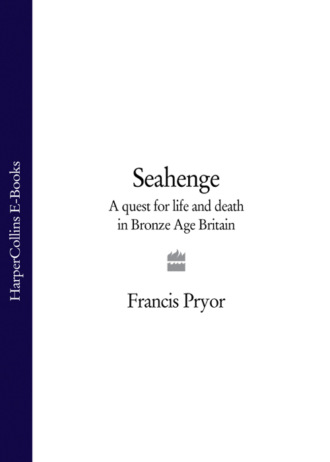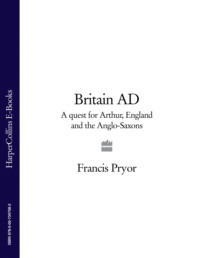
Полная версия
Seahenge: a quest for life and death in Bronze Age Britain

SEAHENGE
New Discoveries in Prehistoric Britain
FRANCIS PRYOR

Copyright
HarperPress
An imprint of HarperCollinsPublishers Ltd. 1 London Bridge Street London SE1 9GF
www.harpercollins.co.uk
Copyright © Francis Pryor 2001
Francis Pryor asserts the moral right to be identified as the author of this work
A catalogue record for this book is available from the British Library
Maps and diagrams by Leslie Robinson and Rex Nicholls
All rights reserved under International and Pan-American Copyright Conventions. By payment of the required fees, you have been granted the non-exclusive, non-transferable right to access and read the text of this ebook on-screen. No part of this text may be reproduced, transmitted, down-loaded, decompiled, reverse engineered, or stored in or introduced into any information storage and retrieval system, in any form or by any means, whether electronic or mechanical, now known or hereinafter invented, without the express written permission of HarperCollins ebooks
HarperCollinsPublishers has made every reasonable effort to ensure that any picture content and written content in this ebook has been included or removed in accordance with the contractual and technological constraints in operation at the time of publication
Source ISBN: 9780007101924
Ebook Edition © JUNE 2012 ISBN: 9780007380824
Version: 2016-09-15
To the memory
of my father-in-law,
DAVID SMITH
Contents
Cover
Title Page
Copyright
PLATES
MAPS AND DIAGRAMS
DATES AND PERIODS
PREFACE: The Quest
PROLOGUE: John Lorimer’s Discovery
CHAPTER ONE: Setting the Scene
CHAPTER TWO: The Hunt is On
CHAPTER THREE: A Trans-Atlantic Commuter
CHAPTER FOUR: Direction and Disorientation
CHAPTER FIVE: Gardens of Creation
PLATES SECTION 1
CHAPTER SIX: Ritual Landscapes
CHAPTER SEVEN: Etton and the Origins of Ancestral Authority
CHAPTER EIGHT: Rites of Passage in a Private World
CHAPTER NINE: The Living Dead: Ancestral Spirits in the Landscape
PLATES SECTION 2
CHAPTER TEN: The Wetland Revolution
CHAPTER ELEVEN: The Daily Round
CHAPTER TWELVE: Between the Tides
PLATES SECTION 3
CHAPTER THIRTEEN: The World Turned Upside Down
CHAPTER FOURTEEN: The Passage of Arms
CHAPTER FIFTEEN: Retrospect and Prospect
FURTHER READING
INDEX
ACKNOWLEDGEMENTS
Keep Reading
About the Publisher
PLATES
(Unless otherwise stated, all photographs are from the author’s collection)
PLATES SECTION 1
The prehistoric landscape at Fengate, Peterborough. The Bronze Age fields were used by livestock farmers between 2500 and 1000 BC.
Unexcavated Bronze Age droveway ditches at Fengate, showing on the stripped gravel surface as dark marks.
The bank that ran alongside a Bronze Age ditch at Fengate was preserved beneath upcast from a modern drainage dyke.
A minor Bronze Age double-ditched droveway being excavated at Fengate.
Body of a young man buried at Fengate sometime between 3500 and 3000 BC.
Gold objects from Barrow G.8 at Wilsford, Wiltshire (2000–1800 BC). (Wiltshire Archaeological and Natural History Society)
Gold grave-goods from a barrow at Little Cressingham, Norfolk (2000–1800 BC). (Norfolk Museums and Archaeology Service)
Sheet-gold cape found at Mold, Flintshire, Wales in 1833. It covered a body which lay under a cairn in a gravel pit (2000–1800 BC). (British Museum)
The Carnac alignments, erected near the coast in Brittany during the Late Neolithic period, around 3500 to 2500 BC (The Ancient Art & Architecture Collection)
The aerial photograph which first revealed the faint cropmarks of the Etton causewayed enclosure (3800 BC). (Photo: S.J. Upex)
Corn-grinding stone, or quern, buried on-edge in the Neolithic causewayed enclosure at Etton (3800 BC).
Aerial photograph taken by J.K. St Joseph in July 1951, showing cropmarks south of Maxey church, Cambridgeshire. (© Crown Copyright 1951/MOD. Reproduced with the permission of the Controller of Her Majesty’s Stationery Office)
The immediate effects of de-watering on waterlogged Neolithic wood (3800 BC) at Etton.
The base of a Bronze Age notched log ladder (1000 BC) found at the bottom of a large quarry pit at Fengate.
The notched log ladder from the Fengate quarry pit.
A notched log ladder in the courtyard of a disused Tibetan Buddhist temple in the Himalayas north of Kathmandu, Nepal. (Photo: Felix Pryor)
Reconstruction of the first Bronze Age roundhouse (c.1500 BC) to be found at Fengate.
Skeleton of a young woman found at Fengate and radiocarbon dated to 3030–2500 BC.
Bronze Age weapons (1300–900 BC) from Flag Fen.
Bronze Age wheel found at Flag Fen, dating to about 1300 BC.
Middle Bronze Age stone roadway (1200–1300 BC) at Yarnton, Oxfordshire.
Clothes of a young Middle Bronze Age woman (1400–1200 BC) found in a barrow at Egtved Farm in southern Jutland, Denmark. (Danish National Museum)
PLATES SECTION 2
John Lorimer holds the bronze axe that started the Seahenge saga.
A view along the Holme-next-the-Sea peat beds at low tide, autumn 1998, showing the timber circle.
The team from the Norfolk Archaeological Unit start working on the ground-plan of the Seahenge timbers.
A close-up of the post circle, showing the eroded and damaged state of the timbers.
The initial exploratory trench within the circle of timbers, autumn 1988.
Part of the inverted oak tree exposed by the excavation.
A post being prepared for removal.
The team’s soil scientist, Dr Fran Green, records the precise position of sample tins placed in the section on either side of a post.
A group of Druids occupy the central tree in an attempt to prevent its removal.
PLATES SECTION 3
Sheets of foam being attached to the central tree to cushion the straps which would be used to lift it.
The lifting of the central oak tree.
The tree trunk was carefully checked when clear of the ground, in case any votive offering or other unexpected find might still be adhering to it.
Members of the Norfolk Archaeological Unit preparing to lift the final two timbers of the Seahenge circle.
The central tree in a shallow water bath at Flag Fen.
The flat underside of the central oak tree was found to be covered with axe-marks, believed to be the earliest left by a metal tool yet found in Britain. One of the towing loops, still with honeysuckle rope in place, is also visible. (Photo: F. Pryor. Courtesy of English Heritage)
One of the Seahenge timbers being carried to the washing tanks at Flag Fen.
Wide axe-marks, similar to those on the central oak tree, were also found on the lower, chopped ends of the oak posts of the timber circle. (Photo: F. Pryor. Courtesy of English Heritage)
The freshly de-barked oak-tree stump with one of the two towing loops and a length of twisted honeysuckle rope ready for the reconstruction of a full-size replica of Seahenge by Channel 4’s Time Team.
The Time Team reconstruction reaches a critical stage, with the oak tree poised above the hole dug to receive it.
The roots of the central oak are levered upwards, and the two-ton tree drops into position.
The tree is manhandled upright.
Aerial view taken during the final stages of the reconstruction.
The interior during the reconstruction.
Excavators working on the Bronze Age religious site at Flag Fen.
An archaeologist reveals part of a wooden axle which had been jammed between two large posts at Flag Fen.
The oak axle from Flag Fen (1200–1300 BC), the oldest known axle found in Britain.
Objects thrown into the waters around the Flag Fen posts as offerings to the gods and ancestors.
A later Iron Age village at Cat’s Water, Fengate, dating to the final three centuries BC.
MAPS AND DIAGRAMS
The Fens
The Fengate Bronze Age fields
Excavated ground plan of a Bronze Age roundhouse at Fengate
Ground plan of the Fengate Neolithic ‘house’, or mortuary structure
Ground plan of Fengate Site 11, showing the position of archaeological trenches
Ground plan of the Neolithic mortuary structure at Fengate discovered in 1997 by the Cambridge University archaeological team
The main features of the Avebury ritual landscape
Ground plan of the causewayed ditches at Windmill Hill, Avebury
The main features of the Stonehenge ritual landscape
Simplified plan of Stonehenge, Phases 1–3
The ritual landscape around Carnac, Brittany
Cropmarks revealed by air photography near the village of Maxey, Cambridgeshire
Ground plan of the causewayed enclosure at Etton, near Maxey
Ground plan of the small henge, with two nested ‘mini-henges’, at Fengate
Bronze Age fields revealed by air photography at West Deeping, near Maxey
A group of ‘mini-henges’ excavated by Gavin Simpson at Maxey, 1965–66
Decorated shaman’s baton from the Maxey ‘mini-henges’
A complex Later Neolithic henge (Etton Landscape Site 2), showing a succession of ditches, pits and post-holes, from the Etton/Maxey ritual landscape
The Maxey Great Henge complex
The oval barrow in the entranceway to the Great Henge at Maxey
Schematic cross-section through features of the Maxey Great Henge, showing phases of construction and destruction
Later Bronze Age wheel-ruts at Welland Bank Quarry, south Lincolnshire
Holme-next-the-Sea and the surrounding area
Plan of Holme timber circle (Source: Norfolk Archaeological Unit)
The forked double posts (numbers 35 and 37) that formed the narrow entrance to Seahenge
The enigmatic Street House ‘Wossit’, Yorkshire
Ground plan of a barrow at Whittlesey, near Peterborough (courtesy of Cambridge University Archaeological Unit)
Fengate and Flag Fen basin, showing the course of the Bronze Age post alignment and timber platform
DATES AND PERIODS

PREFACE The Quest
I DECIDED to write a book on prehistoric religion about two years before the discovery in spring 1998 of the site which has since become widely known as ‘Seahenge’. My original aim was to demystify the subject, to blow away the fog of romance which so often appears when it is raised. I wanted to show how ancient shrines such as Avebury and Stonehenge were made and used by people who were like ourselves. Although they constructed places of worship that seem remote, alien and strange to us, they themselves were none of those things.
I was fascinated by the outward form – the appearance – of their religion. Why, for example, did circles play such an important role? Why were offerings placed in the ground? And why were many sites placed within the fields and lanes of the working countryside, while others were hidden away in inaccessible and remote places? We can only attempt to answer these questions if we try to understand the social context of these ancient beliefs; and to do that, we must examine the evidence provided by archaeology.
I also wanted to write about the way in which modern archaeologists can study discarded prehistoric rubbish, long-lost objects and the fragmentary remains of ancient places to recreate the way people thought and behaved. Like fictional detectives, we make deductions from the slightest of clues; but today, increasingly, we go further than that: we try to understand the motives that drove people in the past to construct great monuments like Stonehenge, or small shrines like Seahenge. Almost daily, new scientific techniques are removing the ties that once restricted our imaginations. But these new freedoms carry with them new responsibilities. It’s becoming easier to sound authoritative, simply by quoting evidence uncovered by science. To reveal a precise date through some new wonder-technique is one thing, but it is quite another to understand why something happened in the past. In this book I want to make a start at answering some of those why questions.
The practice of religion has always happened in the here and now, and I wanted my book to be set in a real prehistoric world, in which children were born and educated, families farmed the land, and law and order prevailed – a world which has been rapidly revealed by excavation in the 1970s and subsequent decades. I decided to use the discoveries made on my own particular excavations to colour the picture I wanted to paint.
My research into British prehistory has been a long quest. It began in 1971 when I directed an eight-year excavation at Fengate, near Peterborough. Fengate is one of the best-known sites in British prehistory. It was continuously occupied for four thousand years, from Neolithic to Roman times, and possesses an extraordinarily diverse succession of settlements, field systems, barrows and burials. After Fengate I turned my attention to two major religious centres: the Bronze Age henges and other shrines at Maxey in Cambridgeshire and the partially waterlogged Neolithic ritual enclosure at nearby Etton. Etton was one of the earliest sites of its type yet found in Britain, and is certainly the best preserved. Then, in 1982, I discovered the waterlogged timbers of what is probably the largest Bronze Age religious site in Europe, at Flag Fen, on the outskirts of Peterborough. I have been working there ever since.
These are major excavations and they have produced a wealth of material, not to mention eight volumes of scholarly research. It is, however, hard to extract the essential narrative thread from this sea of published detail. Moreover, the story emerged only slowly as the research progressed – and this was necessarily at a measured, academic pace. My intention in this book is to tell that tale in a way which reflects, I hope, some of the excitement of the quest itself.
I had scarcely begun putting pen to paper when I learned about the timber circle which had been discovered on the beach at Holme-next-the-Sea on the Norfolk coast, just over half an hour’s drive from where I live. It was an extraordinary coincidence, and one I couldn’t possibly ignore. The discovery created enormous public interest, excitement and indeed controversy. It was certainly remarkable, but to those of us who have been working in the area, it was not unexpected. Large parts of the coastline of eastern England are constantly being eroded by the waves, and significant prehistoric finds are regularly exposed there.
Although Seahenge’s near-perfect state of preservation made it unique, as a small wooden shrine it was not out of the ordinary. Indeed, I myself have seen and dug several like it. This was one of the things that made it supremely important, as it meant that it could be placed within a known sequence of development. We knew approximately where it fitted both chronologically and in the lives of Early Bronze Age communities. We also knew what it may have signified to them. Or rather, we thought we did. But when we started to excavate and study the timbers, we were wholly unprepared for what we actually encountered.
SEAHENGE COMES HOME
The Seahenge excavations happened in 1999 and I wrote this book during the following year. While I was writing my wife Maisie Taylor would leave home every morning after breakfast, allowing me to do the washing-up, and would then drive the twenty-two miles to Flag Fen, where she would work away at the Seahenge timbers which were stored in tanks there. By this time, thank Heavens, the protestors and tabloid press had lost interest. After a few months, English heritage decided to have the timbers conserved by freeze-drying and when Maisie had finished with them they were taken to Wales where they were treated at the Mary Rose Trust’s laboratories. This process was completed early in 2007 and the timbers were then sent to King’s Lynn Museum, where money had been found for a permanent display in the main gallery. That display opened in February 2008 and it really is quite exceptionally good. Maisie and other archaeologists have been working with the design team closely and huge efforts have been made to get every possible detail correct. The new display gives a wonderful impression of what the site would have looked like in the Early Bronze Age, not on the beach, but in a damp and rather mysterious back-swamp behind the coastal dunes.
Scientific research has also been pressing ahead and, with admirable promptness, the full academic report appeared in 2003.* This report confirmed that the site was indeed constructed in the spring or early summer of the year 2049 BC. It also showed that Seahenge was far more complex than a simple timber circle. The central inverted tree was inserted first. Shortly afterwards a forked timber was placed to the south-west (towards the mid-winter setting sun). The forks formed a narrow gap or entrance into the planned circle. Next a screen of ten large timbers, all cut from the central tree, was placed directly opposite the fork, to the north-east. The ‘circle’ was then laid out in a series of ten straight or slightly curved panels. Within this arrangement were additional subtleties. Most of the posts had been driven into the ground with their bark facing away from the circle, like the trunk of a vast tree. But a few had been deliberately set the other way around. We don’t know why this was, but it seems to have been something that happened as part of the initial laying-out.
One of the biggest surprises came when Maisie studied the axe-marks on the timbers. She measured every single one and discovered that over fifty axes had been used – and this just a few centuries into the Bronze Age, when all believed that bronze was still scarce. If fifty axes had indeed been used, that probably means an absolute minimum of fifty people. Allow for friends and families, and the number of folk on that dune in north Norfolk would probably have been closer to two hundred and fifty. It would have been quite an occasion!
So last year the timbers came back home to Norfolk. The King’s Lynn Museum staff have finished the long job of preparing them for display. They also managed to raise money from the National Lottery and other donors to have a brand new gallery built to hold them. I’ve seen all the drawings and computer-generated images and it really is a superb recreation. It’s not just about accuracy; it’s also about atmosphere and what it would have felt like to have been just behind those coastal sand dunes in the early summer of 2049 BC. I am convinced that the people who built Seahenge would find its twenty-first century resting place respectful, yet mysterious – and welcoming.
Francis Pryor
July 2008
* Mark Brennand and Maisie Taylor, ‘The Survey and Excavation of a Bronze Age Timber Circle at Holme-next-the-Sea, Norfolk, 1998-9’ Proceedings of the Prehistoric Society, Vol.69, 2003, pp. 1-84
PROLOGUE John Lorimer’s Discovery
IT WAS EARLY SPRING, 1998, on the south side of the Wash in north-west Norfolk. John Lorimer and his brother-in-law Gary took the path through the pine woods, climbed up the dunes and stood at the top to catch their breath. The tide was now well on its way out, and the peat beds, which ran along the beach midway between high and low tide, were just beginning to be exposed. Between them John and Gary held a brand-new shrimping net, and today was to be its first outing. It was home-made, but sturdy and built to last. They knew it would be futile to test the net until the tide had retreated beyond the peat beds, as only then would the seabed be smooth enough to allow them to drag it through the water, so they decided instead to go crabbing and to test the net in an hour or so. At least that way they’d have something to take home for tea.
Just beyond the beach, behind a coastal barrier of dunes, was Holme-next-the-Sea Nature Reserve. It was a land of birds and dunes, of thin wiry grasses, orchids and Scots pines. And then of course there was the wind. It was always with you at Holme. Sometimes you thought it had dropped entirely, and that the air was truly still. Then you looked at the ground and saw that the blades of grass had never stopped nodding. It was as if someone had just left the room and had shut the door firmly behind them. There were little swirling drafts – not wind, not even a light breeze. Other times, when the weather came from off the Wash, the gales tore at the dunes with a destructive force that even a modern army couldn’t match. Coastal defences were ripped up. I have seen the aftermath of a fierce storm, when wire, fencing, young trees and posts had been hurled inland. In just two hours, a whole summer’s patient dunes-conservation programme could be reduced to a useless, tangled mess.
The Nature Reserve Warden, Gary Hibberd, and his wife Alison lived in The Firs, a large, late-Victorian house that had been built as part of a speculative venture which never got off the ground sometime around the turn of the century. One of the ground-floor rooms had been converted into a small shop and Visitor Centre, and Gary would chalk up a list of rare birds that could currently be seen in the reserve.
The pine trees that were presumably planted when The Firs was built covered the dunes between the house and the beach. They were mainly Corsican pines, a more vigorous species than our native Scots pine and better able to cope with the fierce conditions of this coast. They grew particularly well along the Holme dunes.
John and Gary knew that the best crabs were to be found lurking in dark nooks and crannies below the shelves of peat. John was walking in the shallow water along the edge of the peat. Before he’d even bent down to feel for a crab, his eye was suddenly taken by something green and metallic in the mud. Without thinking, he picked it up and turned it over in his hands. It wasn’t iron, he knew that. Was it brass? Probably. In which case it could have been a fitting – perhaps part of a porthole, or something from off the bridge – from the old wreck behind him, which he could see was just beginning to emerge from the waves. Still, he thought, it doesn’t exactly look brassy. He had seen pieces off wrecks before, and somehow this wasn’t right: it was more coppery, and with a strange, red-gold surface sheen.








